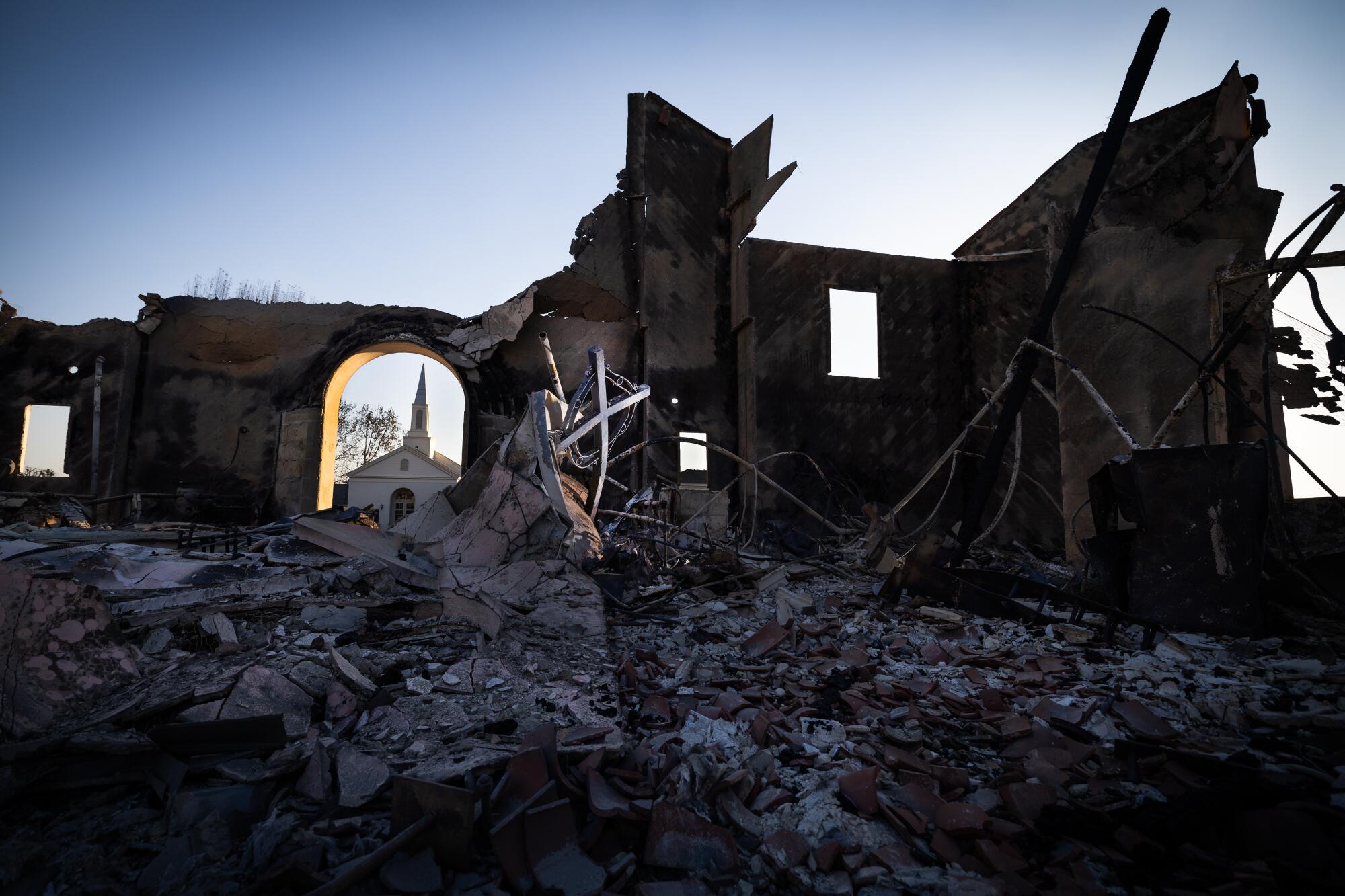
- Share via
For those who first saw the flames from the Eaton fire, they looked small, even manageable.
But the winds in Eaton Canyon were clocked at 59 mph, sending a “shower of sparks” across the mountain.
Rocketing embers lofted by hurricane-force winds would eventually push west from Eaton Canyon into central Altadena, scorching a path of destruction that seemed unimaginable in a community not unfamiliar to wildfire. When the smoke finally cleared, 7,000 structures were lost along with at least 17 lives.
During the first 12 hours of the fire, numerous agencies would work together to try to contain it, including crews from the L.A. County Fire Department, the Pasadena Fire Department, the California Department of Forestry and Fire Protection, Angeles National Forest, the Riverside County Fire Department, the Arcadia Fire Department and a Santa Barbara County task force.
It may take months, or even years, to fully understand why the Eaton fire was so devastating. However, an extensive review of firefighter radio transmissions and interviews by The Times offer a horrifying view of how the fire spread over a period of hours, and the life-or-death decisions that firefighters, police officers and emergency personnel on the ground had to face.
The review found:
- The fire immediately threatened hillside homes around Eaton Canyon. Firefighters got to the scene quickly and saved homes, but winds were by then pushing flames and embers west toward the heart of Altadena.
- As the blaze grew, firefighting resources were no match. Aircraft were grounded almost immediately amid intense wind, and fire operations became more about saving lives than protecting structures.
- Embers traveled up to two miles to the west, passing over some neighborhoods but hitting central Altadena hard. Within hours, entire blocks were on fire.
- Early Wednesday, fire officials realized mass evacuations were the only answer. With that, a sickening reality set in. “I’m going to lose half of my town,” Pasadena Fire Chief Chad Augustin recalled.
Hour 1: Raining embers

When Michael Olson saw the Eaton fire start on a hillside above his Pasadena home on Jan. 7, his first thought was that it was so small he could fight it himself.
It was more than an hour after sunset, and the 70-year-old recruiter was working at his home office when a neighbor pounded on his door and yelled about a fire.
Residents grabbed their phones to record images of the nascent blaze as it flickered beneath a transmission line in Eaton Canyon Park.
But curiosity soon turned to terror.
“In a minute it doubled. In 10 minutes, the entire vista was blazing,” he said.
“I couldn’t see the sky,” Olson recalled. “It was just a mountain of flame.” The mountain was on fire “from soup to nuts, the whole thing. You couldn’t see anything else.”
Winds sent a “shower of sparks” toward homes. Only a dry riverbed separated his Canyon Close Road neighborhood from the burning hillside. The fire spreads.
‘In a minute it doubled. In 10 minutes, the entire vista was blazing.’
— Michael Olson, Pasadena resident
Meanwhile, Pasadena Fire Battalion Chief Danny Nausha and his team arrive a few blocks south near the Eaton Dam stables and catch glimpses of the fire burning below the electrical tower. Signs of spot fires also begin popping up to the east, south and west.
At 6:26 p.m., fire personnel radio their first account of the growing blaze: “We have an approximately 10-acre brush fire across canyon underneath high tension power lines.”
It had been just minutes since the fire was sparked, but with the powerful winds, Nausha said, it was clear firefighters were facing a potentially disastrous fire.
“Instantly going into it, I knew we’re not going to be able to get to it right now,” he said. “We can’t get to it, so we got to get people out of here.”
Nausha, the first incident commander for the Eaton fire, said he stationed crews in neighborhoods immediately west, east and south of the fire, as close as possible to the fire’s edge to keep it from reaching homes.
It was unclear if the homes could be saved, but it could give residents a chance to flee.
“My plan, ultimately, it was life safety, and minimize the footprint of that fire,” Nausha said.
Fire officials to the west, south and east of the ignition point begin reporting heavy rain of embers and spot fires below the hillside.
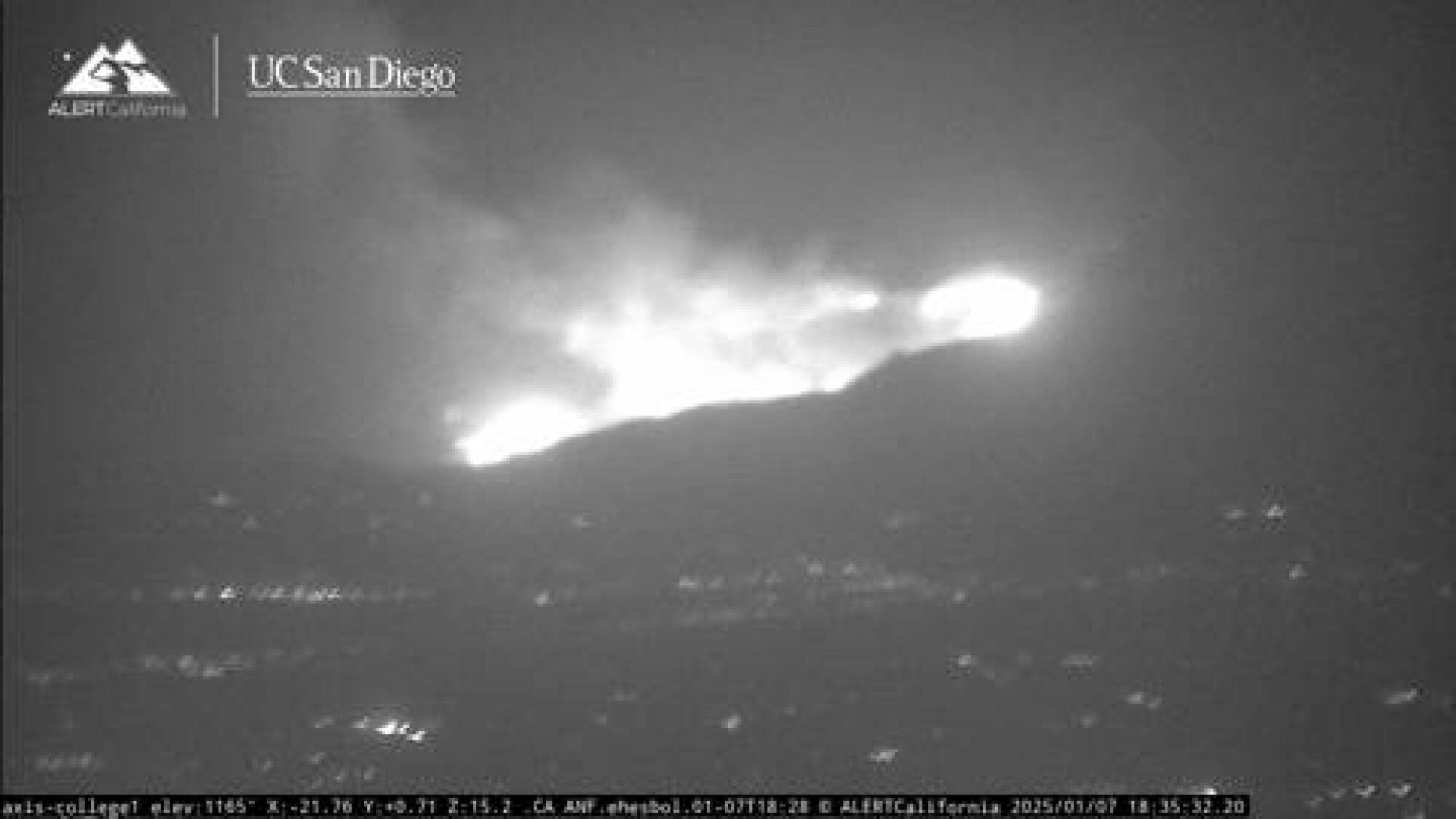
Firefighters were protecting homes at the fire line, Nausha said, but embers being carried by 50-mph winds and 80-mph gusts were already lighting homes on fire as far as a mile away from the flames, behind firefighters.
Meanwhile, Nausha said, winds continued to act erratically — spreading the fire east, west and north. With fire crews chasing the flames and expanding their line, firefighting resources are spreading ever thinner across the region.
At this point, Nashua’s main goal is getting people out and safe.
At 6:42 p.m., a helicopter pilot monitoring the fire says the biggest threat is to Kinneloa Canyon, on the fire’s eastern flank. Three minutes later, he relays an ominous message: “We’re getting a 70-knot [80-mph] wind speed. We’re gonna have to shut down water-dropping operations. Also, you can cancel with traditional copters.”
The Eaton Canyon Nature Center is now alight. Fire crews attempt to put out the blaze, but at 7:02 p.m., they radio: “We had to bail out. Fire’s overrun.”
More neighborhoods are burning.
“It was just crazy, — the amount of fire, and the way it just exploded in all different directions, carrying the embers everywhere,” Nausha said.
By 7:07 p.m., crews on the ground are asking regional agencies for additional resources, including 10 strike teams and 20 engines, but equipment and personnel across the county have been spread thin in anticipation of “particularly dangerous” winds.
‘We could have used a hundred fire engines by then. You already had ember casts reaching blocks ahead of the fire.’
— Pasadena Fire Chief Chad Augustin
Carter Johns was in his bedroom on Roosevelt Avenue when he heard sirens about 7:15 pm. The 17-year-old looked outside and saw the mountainside north of his family’s Altadena home was a sheet of flames.
Embers were sailing down on roofs, Johns recalled. He ran down the street banging on doors.
“People had no idea,” he said.
At 7:17 p.m., a dispatcher says an additional air-attack helicopter is inbound with an arrival time of 7:30 p.m.
But the helicopter never arrives; heavy winds force it to land. There will be no air support as the Eaton fire spreads.
At Hollywood Burbank Airport, gusts are now clocking in at over 60 miles per hour.
Hour 2: Firefighters mount a defense
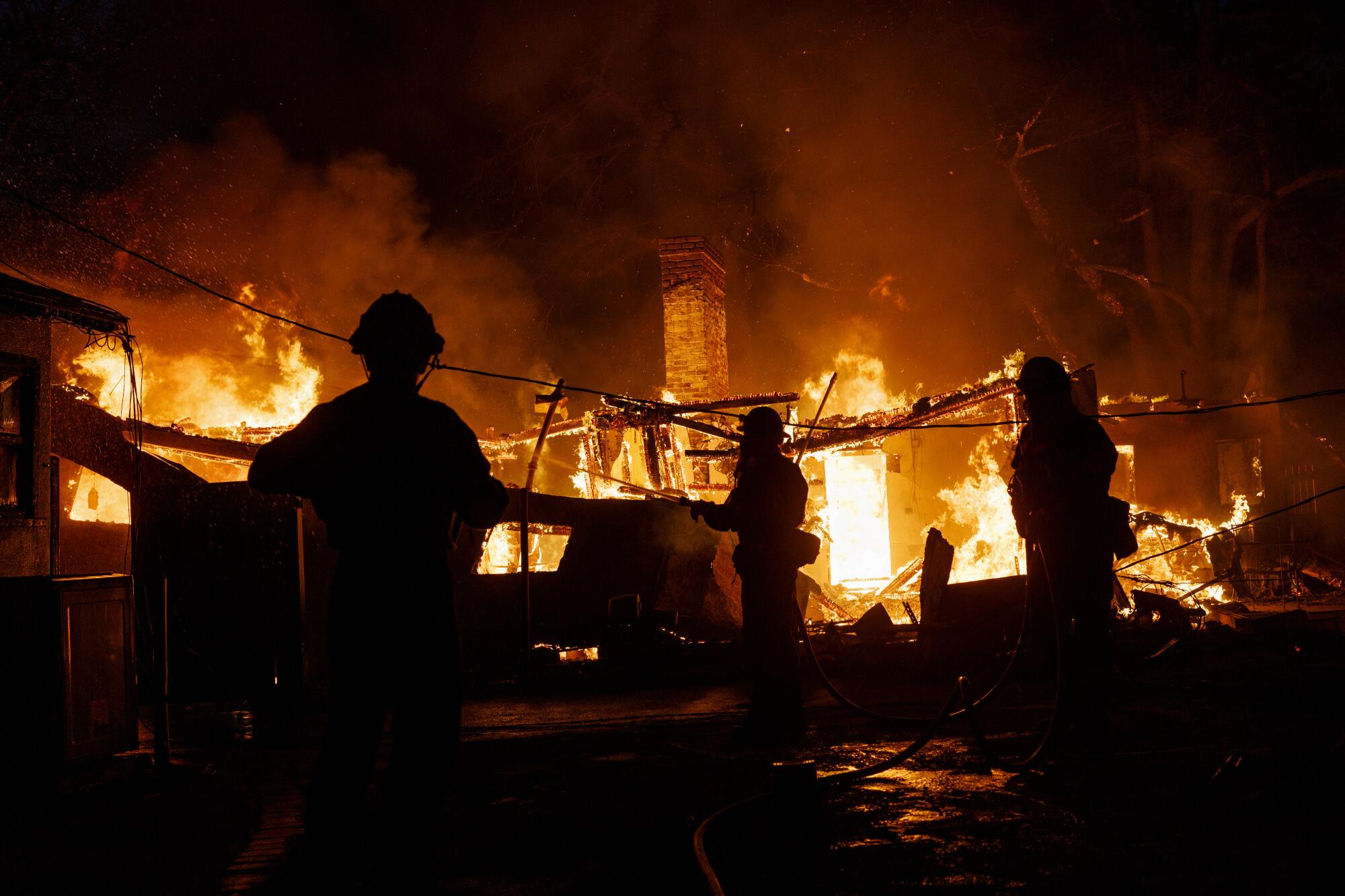
It’s 7:24 p.m. and the members of a battalion are fighting flames near L.A. County Fire Department Station 66 when a call comes in from another nearby unit.
The fire is wrapping around them.
“It’s getting pretty thick up here,” the battalion operator replies. He says they have no fire engine but have worked to get people out of their homes. “We’ve done our best evacuating,” he says and sighs. “We’ll have to start pulling out of here.”
As firefighters labor to protect some homes closest to where the fire ignited — including several blocks that back up to Eaton Canyon — red embers stream past, igniting brush, trees and homes.
‘Our initial crews were able to do a lot of protecting of structures, but that’s where the ember casts come into play.’
— Chad Augustin
A 7:28 p.m., radio call reports that the Creekside court community south of New York Drive is on fire. It will be the closest area to the ignition point that sustains the most damage. The ember cast, blown due south by high winds, will devastate the area on the west side of the Eaton Canyon reservoir.
On at least three fronts, units are requesting more resources: Canyon Close Road to the west, New York Drive to the south and the Kinneloa Mesa area to the east.
Laurie Bilotta, who lived through the 1993 fire on Canyon Close Road, can barely stand upright in the wind.
Twelve engines have fanned out from her home, the site of the first response to the fire, and crews are fighting the blaze along her street.
The sky is pitch dark with smoke when she and her husband evacuate at 7:30 p.m with huge embers raining down around them.
‘You were going two miles per hour because you couldn’t see in front of you.’
— Laurie Bilotta, Altadena resident
At 7:49 p.m., an operator says that structures north of Veranada Avenue — the west side of the blaze — are in flames, and “the fire is going to push continually west into the structures.”
Crews on the ground are struggling to protect homes and evacuate neighborhoods, but the pace of destruction forces firefighters to choose between one or the other.
‘Homes were burning and lives were threatened, and both police and fire went in trying to fight the fire, but a large amount of crews went into evacuation mode.’
— Chad Augustin
At 8:03 p.m., an emergency message alerts firefighters to another crisis: “Flames impinging on a convalescent hospital. Evacuations in progress. No fire department on scene.” Fire personnel are diverted to the scene to help, Augustin said. The assisted living facility would ultimately burn to the ground, but over 200 people would be saved.
Hour 3: Stretched thin
Two hours after the fire ignited, the Pasadena Fire Department has staffed every reserve engine in its arsenal. In the chaos, firefighters head out with whatever engine is nearby, or in need of more staff. There is little time to make or draft formal assignments.
‘We said, “We’ll clean this up later when we get the time.” We were dumping our entire resources to save lives.’
— Chad Augustin
At 9:09 p.m., the fire pushes east past firefighters in Kinneloa Mesa and toward the Eaton Canyon Golf Course and Hastings Ranch neighborhood of Pasadena. Dispatch asks if the unit there can spread out and cover the expanding fire.
The response: “We’re stretched kind of thin, it’d be really fragmented. This wind is really kicking up right now, and it’s sometimes it’s going northeast and then it’s pushing northwest. So it’s really squirrelly out here, and all my resources are committed right now, but I might be able to squeeze something out for you. Not much though.”
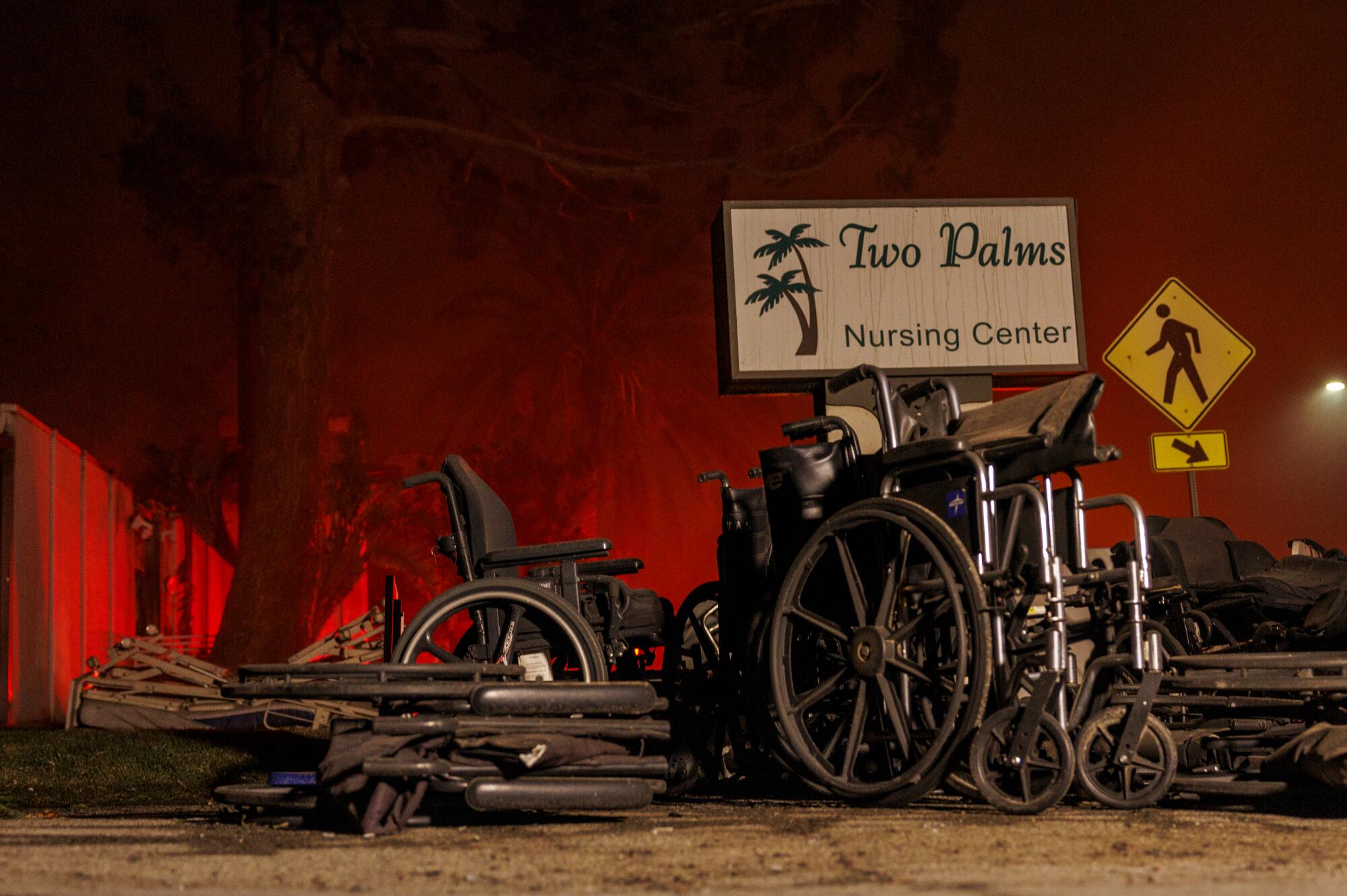
Another incident commander takes lead of the fire, and Nausha and a crew then head down into the city, responding to calls of homes and buildings on fire far away from the flames that continue to move east, west and north.
It’s a grueling task: pulling up to a home to check for people to help them evacuate, while trying to put out flames that are being reignited by torrents of embers — then packing up and moving to the next building.
Firefighters, police, sheriff’s deputies, paramedics and bus drivers are helping people evacuate.
Winds are pushing in all directions. Firefighters spread out to protect the homes they can, but embers are blowing past and over them, into communities deep within Pasadena and Altadena. Homes as far as two miles away from the blaze are catching on fire.
Hour 4: Backup en route
At 9:17 p.m., four engines are battling fires on Woodlyn Road and Del Rey Avenue, near the fire’s southern edge in Pasadena. “We have multiple homes going up,” they report. “We’re just bumping and running. If we can get any resources over here, that’d be great.”

Minutes later, incident command tells operations that four of the 10 additional requested strike teams — each consisting of five engines and a leader — are en route, and six more are on order.
Hour 5: Home after home up in flames
At 10:34 p.m., an official explaining what resources they have says “we’ve been begging, borrowing.”
By 10:43 p.m., there are two staging locations: New York staging, just south of the ignition point, and Baldwin staging on the eastern front. There is no staging location on the western front.
Scott Brown, a firefighter assigned to Los Angeles County Fire Station 66, had been off-duty when the fire broke out.
A lifelong resident of Kinneola Canyon, Brown will spend the night protecting his home and neighborhood as best as he can.
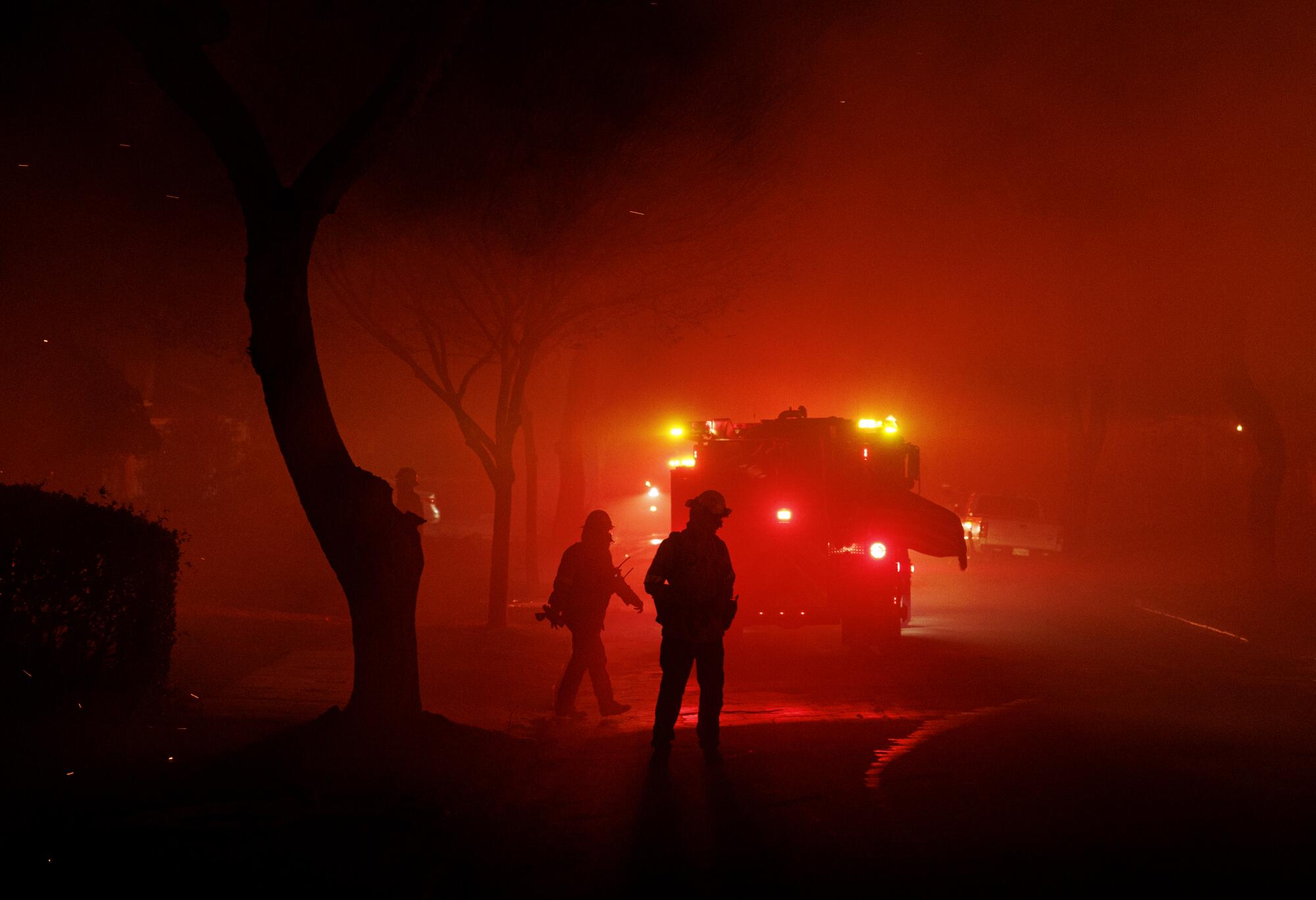
His area, and those immediately around Eaton Canyon, will survive mostly unscathed.
At 10:51 p.m., three separate structure fire alerts come in: one home in Kinneloa Mesa, a series of homes just west of North Altadena Drive near Eaton Canyon, and an ominous third location: East Calaveras Street, at a home in the heart of Altadena and some 2 miles southwest of any previous report of fire.
‘It could be winds, brush clearance, luck...’
— Scott Brown, firefighter
Hour 6: More neighborhoods ablaze
‘Every resource that arrives immediately goes into rescue mode, that means that nobody’s fighting the fire.’
— Tim Chavez, retired CalFire fire behavior analyst
At 12 a.m., a deputy reports multiple houses on fire on North Holliston Avenue near East Altadena Drive. The western edge of the fire continues to move deeper into residential blocks.
Hour 7: Block after block burns, resources thin
By 12:47 a.m., fire officials are battling flames on multiple fronts — in the hills above Sierra Madre on the east, in dense blocks of housing a mile from the Eaton Canyon trailhead around North Altadena Drive to the south and in an expansive western frontier that stretches from the mountains down to the Altadena Golf Course.
Meanwhile, radio traffic suggests firefighting reinforcements have been depleted:
“Engine 32, you won’t be getting any more resources,” an operator responds when asked for additional firefighting forces.
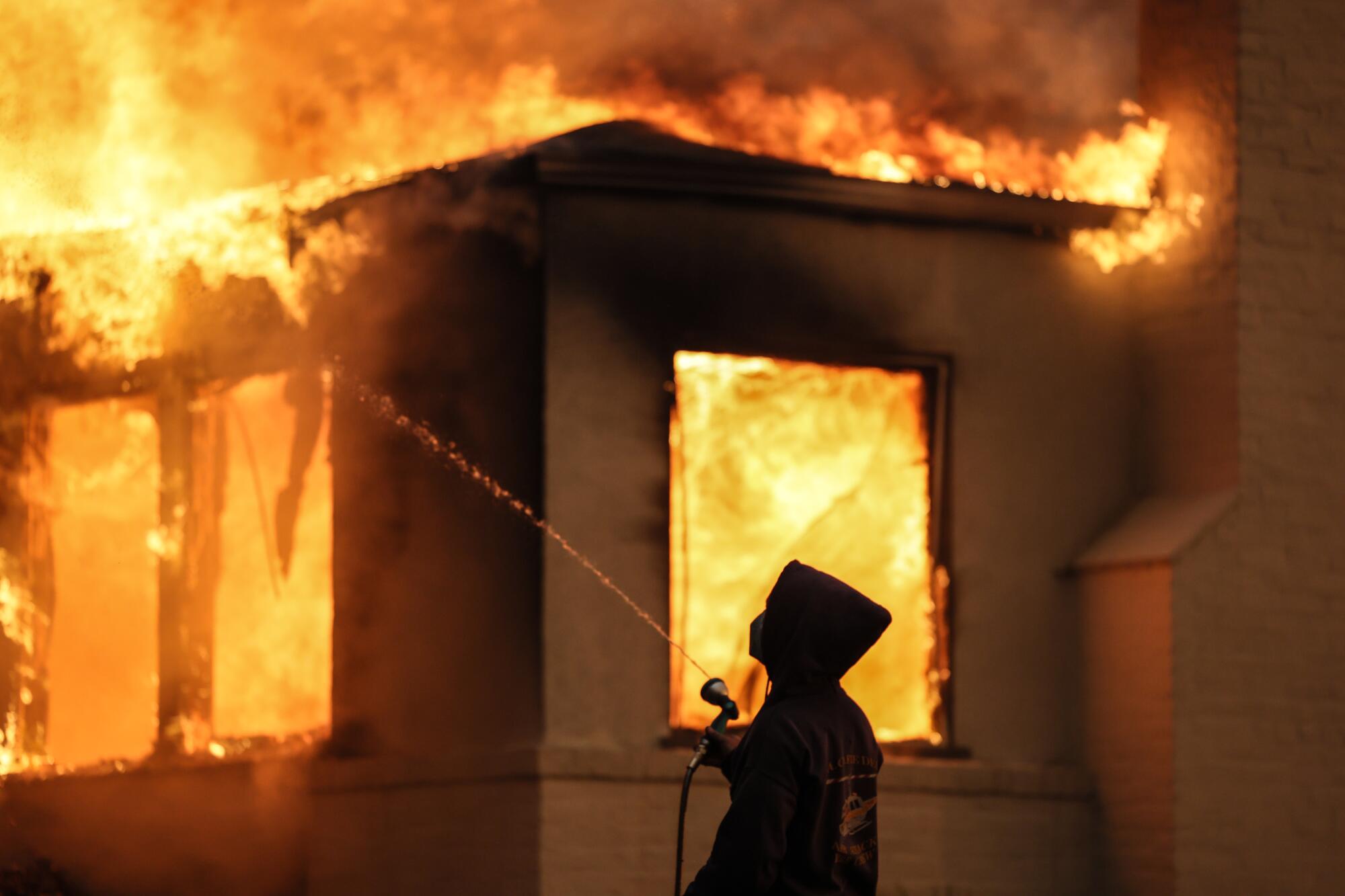
“Priorities are life and structure defense. Try to cut it off,” says another.
At 12:54 a.m., an official notes: “I think we’re starting to really run short with that third fire that jumped off,” likely referencing the Hurst fire, which began around 10:30 p.m. in Sylmar and rapidly expanded.
Shortly before 1 a.m., a dispatcher tells units operating around Eaton Canyon and to the east: “We’re gonna be running really thin tonight, so if I could just get one engine up every street, that’s kind of my objective there.”
At 1:22 a.m., with flames moving closer to her home, Erliene Louise Kelley, 83, sent a text message to her granddaughter Briana Navarro. “In the living room looking out,” she wrote. “I’m going to take a picture.” The picture never arrived. On Jan. 9, Navarro said, police informed the family that a body had been discovered in the rubble where the house once stood.
Hour 8: A destructive march west
Hour 9: ‘We have to get out!’
At around 2 a.m., Shari Shaw decided she would die if she did not evacuate her Monterosa Drive home. She said she begged her brother Victor Shaw, who had diabetes and chronic kidney disease, to leave with her. “Victor, we have to get out!” she screamed. She tried multiple times to get him to go, to no avail. All through the night, she said her calls to his cellphone went to voicemail. His body was later found on the walkway outside the front door.
At 2:34 a.m., several officials say there is no fuel at Los Angeles County Fire Station 11 in central Altadena. At Fire Station 82 in La Cañada Flintridge, the diesel pump is also out of service, they say.
As the fire spreads toward the west, emergency officials have a troubling call to make: Should they order all residents to evacuate areas north of the 210 Freeway?
Augustin decides there’s no other option, but acknowledges a terrible possibility: “I’m going to lose half of my town.”
‘It’s a terrible feeling.’
— Chad Augustin
Hour 10: Entire streets on fire
For hours, crews are running from one fire spot to another. Every tree and home that catches fire turns into another source of hot embers that can push fires even deeper into neighborhoods.
“If a house catches fire, that house with 80-mph winds then increases the fire behavior and then blows embers down,” Nausha said. “We were constantly trying to fight fires, trying to get the embers, trying to control the ember cast and moving on, and continuously moving on and on.”
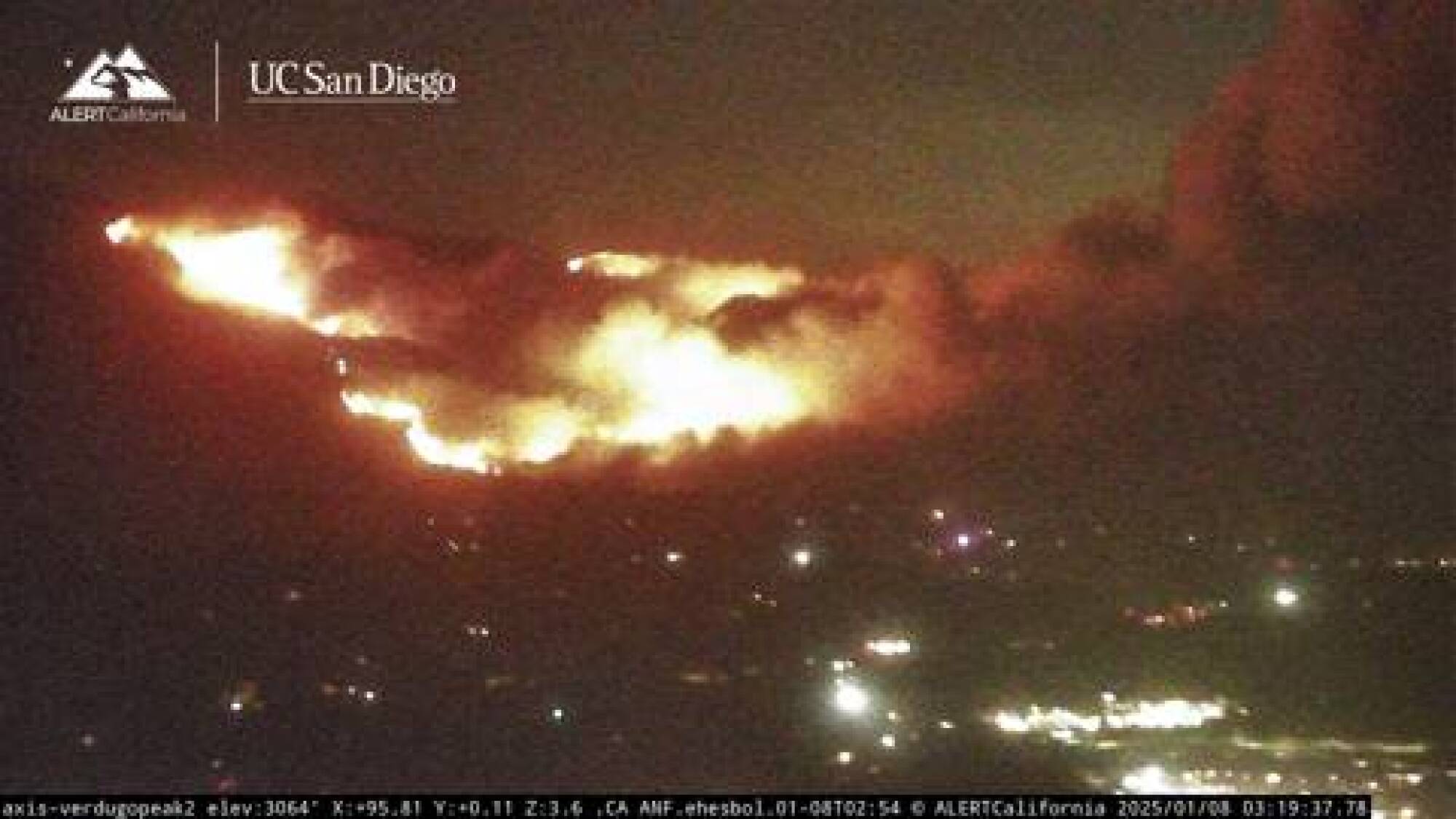
At 3:45 a.m., a fire unit on the southern front asks if they can “order an excavator to tear apart some buildings that are partially down,” as “they’re throwing off a pretty serious ember cast.”
‘One structure catches fire … and it throws embers downwind to the next structure, and the sequence is pretty much unstoppable. There’s just no good way to build fire line in an urban environment.’
— Tim Chavez
Hour 11: Death and despair
After 10 hours, entire streets are ablaze. Divisions have been battling the fire on multiple fronts for hours on end, with high winds spreading the blaze beyond their control. Resources have been diverted to the third concurrent major fire in Los Angeles county.
At 4:42 a.m., the radio reports a person trapped inside a burning home on Tonia Avenue. Days later, the Los Angeles County coroner’s office would confirm a death at that address and another in the same block.
At 4:46 a.m., an urgent message from dispatch: “we need to get at least one engine to Altadena Sheriff’s station.” The engine is sent and the station is saved.
At around 5 a.m., Anthony Mitchell Sr., an amputee who used a wheelchair, and his son Justin, who had cerebral palsy, waited in their Altadena home. Family members told The Times that Anthony Mitchell reassured them on the that he was fine and was awaiting an ambulance to rescue them. They were both later found dead.
‘The only thing you can do is get people out of the way and wait for the weather to change. That’s pretty much what happened.’
— Tim Chavez
Hour 12: Radio dispatch inundated with house fire reports
At 5:26 a.m., the structure fire reports get more frequent. Each report contains multiple addresses. The radio chatter mostly consists of dispatchers relaying information. The divisions battling the blaze barely respond, possibly too busy fighting fires.
By 6:11 a.m., 12 hours after the Eaton fire began, radio traffic is mostly limited to assisting evacuations and those trapped in burning buildings. The blaze has mostly reached the limits of its urban footprint.
Priority is life-saving. Homes are left to burn.
‘I don’t know how the fire resources could have been any more prepared for what happened, but honestly, I don’t know that having 100 more engines would have made any difference.’
— Tim Chavez
Fire would march relentlessly through Altadena, past North Lake Avenue, North Marengo Avenue, Fair Oaks Avenue. The destruction only began to lessen at Lincoln Avenue. Some homes were lost west of Lincoln, but the fire appeared to lose momentum with lessening winds.
More to Read
Sign up for Essential California
The most important California stories and recommendations in your inbox every morning.
You may occasionally receive promotional content from the Los Angeles Times.













